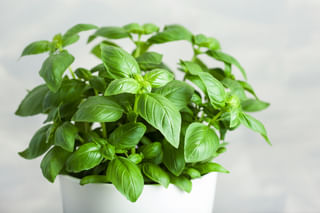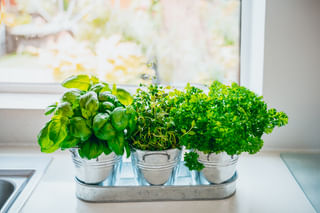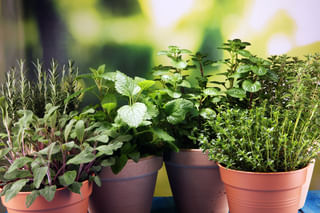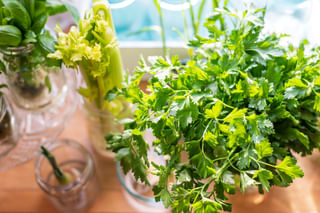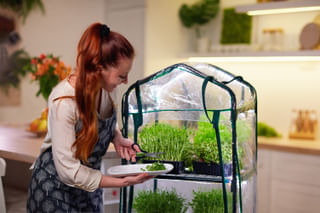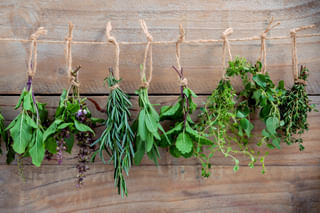How to start an indoor herb garden
Learn how to start your own indoor herb garden for fresher and cheaper dinners. Discover the best herbs to grow indoors, tips for creating the perfect environment, and delicious recipes featuring fresh herbs. Start enjoying the benefits of fresh herbs in your cooking today!
If you've taken care of houseplants for a while and you're looking for a challenge, or perhaps you're just looking to add extra flavor to your cooking, nothing can beat fresh herbs! I'm a huge fan of fresh herbs like basil and mint to make improve my dinners and drinks.
Did you know it's not as difficult to grow these herbs as you might think? Do you get excited by the thought of always having fresh herbs to use in the kitchen, or do you simply love the smell? This guide is for you!
Buying herbs and spices is easy, but it's always a little extra special if you've grown the herbs yourself. In this guide, I'd like to help you get started with growing your indoor herb garden. If you've tasted your fresh herbs in your meals or drinks, you'll never want to go back to buying the herbs from the store.
It's not just the taste that'll sell growing your herbs, it's also the incredible smells you'll have in and around your kitchen at all times of the day.
In this guide, we'll go over these steps to help you get started with your herb garden:
Let's get started and learn how we can start to grow our herbs indoors!
What are the benefits of growing herbs indoors?
So you're thinking of starting an indoor herb garden? Growing your herbs indoors has many benefits. Firstly, with an indoor herb garden, you have access to fresher and more flavorful ingredients for your meals that you can harvest when you need them.
You can save money on grocery bills by growing herbs from seeds rather than buying them fresh from the store every week. Like taking care of plants, growing herbs is also a great way to relax and help decrease your stress levels.
A variety of herbs offer many health benefits due to their high antioxidant content and medicinal properties. As a bonus, herbs like lavender, mint, and lemon balm can help keep insects away while making your house smell incredible. By planting herbs indoors, you're not only encouraging healthier eating habits but getting a chance to enjoy fresh aromas in the comfort of your own home.
So an indoor herb garden helps you to relax, makes your house smell incredible, and can help you feel better, but there is more! Having an indoor herb garden also adds some greenery and texture to your house. Combine these new colors and textures with the incredible smells and you'll feel like you've traveled abroad in an instant!
But the best part of all of this? You don't need a lot of space to get your indoor herb garden started! Whether you live in the city, in a smaller apartment, or the country in a spacious house, there are indoor gardens of all shapes and sizes that'll fit you and your living spaces!
How do you start an indoor garden?
If you want to start your home herb garden, there are several steps you need to take.
Find herbs to grow
First, you need to decide which herbs you would like to grow. This can include anything from basil and oregano to rosemary and thyme. If you're unsure which herbs to start with, look up a few recipes of food you enjoy eating and find out which herbs the recipe recommends. It's great to start with 2-4 herbs, so you'll always have some fresh herbs on hand.
Find the perfect growing spot
Once you have picked out some herbs that you'll be growing, it's time to consider where you will plant them. Finding a good location that gets enough (indirect) sunlight is key. Ideally, you'd place your herbs in a space that gets six or more hours of sunlight per day. A west- or south-facing window is a great place. Further on in this guide, we'll look at this in some more detail.
Get your growing supplies
Next, it's time to get supplies for planting your herbs. Luckily, you don't need a lot of supplies to get started. If you regularly take care of houseplants, you might already have everything you'll need. The supplies include potting soil and containers. Depending on the size and number of plants, these containers can range from small terra cotta pots to larger plastic containers.
Plant your herbs
After collecting all of the necessary materials and supplies, it's time to start planting! Every herb is different, so make sure to pay attention to their needs: some require full sun while others do better with partial shade.
Some herbs need moist soil while others prefer drier conditions; some herbs have roots that grow deep down into the soil while others just need shallow places for their roots to spread outwards.
One of the most important parts of planting your herbs is to leave some space between plants based on how big each herb grows when they're fully grown so they have enough room to grow without damaging the other plants.
Take care of your herbs
Once everything is planted and watered, make sure to regularly check on your herbs throughout their growing cycle. Prune them as they get too big for the available space or if they become too crowded together in their pots.
Like other houseplants, make sure to keep an eye out for pests like aphids or whiteflies as well as diseases such as powdery mildew that can affect certain plants.
A fantastic way to prevent pests is to use a concept called companion planting or spraying diluted neem oil on your herbs. Companion planting is a type of gardening in which you strategically plant different plants together. Some plants provide mutual benefits to others when you grow them close together, such as attracting helpful insects, repelling pests, or improving soil quality.
Now that you have a basic idea of how to get started with indoor gardening, let's look at some great herbs to grow indoors!
What are the best herbs to grow indoors?
Now that you've got a basic idea about starting your home herb garden, let's see which herbs might be great for you to start with! The best herbs to grow indoors depend on your plant care and cooking habits.
The most popular herbs indoors
Basil, mint, thyme, oregano, parsley, and cilantro are all popular herbs for indoor gardening. All of these herbs can be grown in pots or containers indoors with enough light from a sunny window or artificial lighting.
When selecting herbs for growing indoors, consider how much sunlight the space receives and how much moisture the plants need. For example, basil prefers full sun but will tolerate partial shade, while mint thrives in semi-shady spots with plenty of water.
Flavors and aromatics
Besides the growing space, it's also important to think about what flavors you like and when you plan to use them. Herbs such as lavender, rosemary, and sage are ideal for adding an aromatic touch to your home while culinary herbs like dill, chives, and bay leaves are great for cooking.
High or low-maintenance herbs
If you're looking for a low-maintenance plant that can thrive without frequent watering or pruning, consider kaffir lime or curry leaf, both of which are drought-tolerant varieties that require minimal care.
Herbs such as tarragon may take some extra effort due to their seed germination needs but can still be grown indoors successfully if given the right environment and regular attention.
Smaller or larger herbs
Finally, don't forget about container size when picking out your indoor herb garden! Picking out smaller containers will allow you to move them around more easily so that they can get the proper amount of light throughout the day, which is key for healthy growth.
Now that you've got an idea for several great herbs to grow indoors, let's look at how you can pick a spot for them to grow in your house!
How do you pick a space for an indoor garden?
Some of the herbs you've picked out might need more sunlight than others, so let's figure out which spaces in your house are great for growing herbs and which unique benefits these spaces bring.
Use windowsills for growing herbs
One of the most common indoor spaces used for herb gardening is a windowsill. Windowsills provide plenty of natural light and airflow that herbs need to thrive, making them an ideal spot for growing your favorite herbs.
Windowsills also offer easy access for watering and trimming plants, as well as providing a great view of the herbs from inside the home. The downside to using windowsills is that they tend to get quite hot during the summer months, which could potentially damage your herbs if you don't pay attention.
A great way to keep your herbs cool in the summertime is to use window coverings or awnings over windowsills that get direct sunlight throughout the day.
Use hanging planters for growing herbs
Besides windowsills, you can also grow herbs in hanging baskets or other containers that hang from the ceiling or walls of an indoor space.
Hanging planters aren't just convenient, they also add a design feature to your living spaces. They also allow you more flexibility when it comes to spacing out your plants because you're not limited to floor space like you are with potted plants.
Use smart gardens for growing herbs
If you don't have a lot of sunlight, you can still successfully grow herbs indoors! For those darker spaces, you can use smart gardens. These smart gardens typically come in small planters or boxes that can easily be tucked away on shelves or those dark corners.
Smart gardens often water themselves and have a grow light included, so they're low-maintenance and will help you grow herbs in even the darkest corners of your living spaces.
How do you plant and care for herbs indoors?
So you've found the perfect spot for your herbs, and now you're ready to plant them and take care of them until you can harvest them. Let's see how you can take care of your herbs and how you go about planting them indoors!
What is the best time to plant herbs indoors?
Like many houseplants, the best time to start planting herbs is in the late winter or early spring. During these few weeks, the sunlight is getting stronger, the temperature outside is going up gradually, and plants are entering their growing season.
This is the best time to plant your herbs, as they can grow roots quickly and prepare for a summer of plenty of sunlight. Since it's getting warmer outside, your central heating won't be turned on as much, so the air indoors is getting more humid. This creates the perfect growing conditions for many of the most popular herbs.
The spring and summer are also the best time to propagate any of your herbs. The cuttings will recover quickly and grow roots in 1 or 2 weeks.
How often should you water herbs indoors?
Most herbs prefer their soil to be moist at all times because they generally don't store a lot of moisture in their stems and leaves. These herbs rely on the soil to provide them with moisture to grow.
An important thing to keep in mind is to check the soil first before adding water. The herbs likes the soil to be moist, but not soggy. Lastly, keep an eye out for signs of overwatering such as droopy leaves or yellow foliage.
Because most herbs prefer moist soil, you'll need to plant it in soil that's specifically mixed to be moist most of the time. Let's find out how to do this!
What is the ideal soil for growing herbs indoors?
The ideal soil for herbs is soil that stays moist for multiple days but doesn't retain so much water that it's soggy. Herbs are also very fast-growing plants, so they'll need a lot of organic material in the soil to absorb enough nutrients to stay healthy.
The ideal soil mix for herbs is a mix between potting soil, peat moss, and perlite. The potting soil and peat moss provide your herbs with organic material to give them the energy to grow. The peat moss helps to keep the soil light and airy, so it doesn't compact over time. The perlite provides excellent drainage to the soil, so any excess moisture drains from the pot or container quickly.
The organic-rich soil will help your plant grow, but it'll need fertilizer during the growing season to stay healthy long-term. Let's see how often you need to fertilize your indoor herbs.
How often should you fertilize herbs indoors?
Fertilizing is very important for plants to stay healthy during the growing season. During this time of year, in the spring and summer, your herbs will grow very quickly, so they'll use a lot of energy. It gets some of the needed nutrients from the soil, but you'll need to supplement these nutrients with fertilizer.
During the spring and summer, you should fertilize your herbs with a diluted liquid fertilizer every two to four weeks. You can add liquid fertilizer to the water you use to water your plant to help your herbs absorb the nutrients more quickly.
You can use any general liquid fertilizer to help your herbs grow during the growing season. If you can find any herb-specific fertilizers, those are the ideal choice.
How much humidity is ideal for growing herbs indoors?
To give your herbs the best chance of success, you'll need to give them the right levels of humidity. Most indoor herbs prefer a humidity level ranging from 50%-60%. Luckily, most houses naturally have humidity levels in this range already, so chances are that you won't need to do anything to raise the humidity.
If your house is particularly dry, you can use a humidifier or place trays filled with water near your herbs. Another great way to help raise the humidity around your herbs is to place them close together, so they can "share" moisture.
What is the best temperature for growing herbs indoors?
Another important part of making sure your herbs are as comfortable as possible is to provide them with consistent temperatures during the year. Most indoor herbs prefer temperatures between 18℃ (65℉) and 21℃ (70℉). Like with the humidity, most houses are already at this temperature during the day and night, so you likely won't have to change a thing.
If you accidentally expose your herbs to temperatures that are too low, it may prevent growth. Temperatures that are too high can cause wilting or damaged leaves. If possible, place thermometers around your living space so that you can actively monitor the temperature and make adjustments as needed.
Do I need to prune herbs that grow indoors?
The final aspect of keeping your herbs happy and healthy is to regularly prune them. Regular pruning will keep your plants looking tidy while also helping to promote new growth. The best part of pruning is that you can use the cuttings with your cooking or propagate them to grow new plants.
If you notice your herbs becoming leggy or tall, simply pinch off the leggy stems just below a node. However, make sure you don't remove more than 30% of the plant at once as this could cause stress to your herb.
How do you know your indoor herbs are ready for the kitchen?
Now the best part of taking care of herbs, at least for me, using them in the kitchen! But how do you know your herbs are ready to be harvested? Let's find out!
How do I know when my herbs are ready to harvest?
Knowing when your herbs are ready to harvest is an important step in preserving them for long-term use. To find the ideal time to pick your herbs, pay attention to the size and color of the leaves. Generally, most herbs will be ready to harvest when their leaves have grown to full size and their color has become vibrant. The flavor of the herbs will also be at its peak right before they are harvested.
When it's time to harvest your herbs, you can either use fresh herbs in your recipes or you can store them for long-term use. This is a great way to enjoy your herbs for many months. Let's see how to do this!
How do I preserve my herbs for long-term use?
Once your herbs have reached their prime state, it's important to preserve them quickly so that they can still be enjoyed later on. One popular way of preserving herbs is by drying them. You can do this by laying them out on a baking sheet or hanging bunches upside down in a warm and dry area with plenty of ventilation, such as a sunny windowsill or screened porch.
When the herbs are completely dry, crumble them into small pieces and store them in an airtight container away from direct light and heat sources. This method works best for hardy herbs like oregano, thyme, rosemary, and lavender.
You can also preserve herbs by freezing or refrigerating them. Freezing usually requires blanching the herbs first in boiling water before placing them in freezer bags or containers. This prevents them from becoming limp or discolored while they're stored in the cold.
Soft-leaved herbs like parsley, cilantro, mint, chives, and basil can also be frozen but do not need blanching beforehand- these should instead be chopped finely and placed into ice cube trays filled with water before being frozen into cubes that can then easily be dropped into recipes while cooking.
By choosing one of these methods, you can enjoy your own herbs for many months, even if the conditions are no longer right for fresh herbs!
Conclusion
Starting your own indoor herb garden is easier than you might think! It doesn't take much time or effort as long as you follow the tips from this guide. There are hundreds of different varieties to choose from so you can find one that fits your tastes and preferences. Whether you're looking for a way to save money on fresh produce or just want more greenery in your home, having an indoor herb garden is a great choice.
Even if you live in a small space, you can grow fresh herbs indoors. You don't need a large greenhouse to have the best ingredients in the kitchen!
Above all, herbs are easy to grow indoors, making them ideal for beginners. Even if you live in a small apartment in the city, you can easily enjoy the benefits of having an indoor herb garden since most herbs require minimal care and attention, and will thrive in nearly any container.
Share this guide with your friends and family to help them start their indoor herb garden and tell them about all the benefits of growing herbs at home!
Thank you for reading this post! I hope it helps you to keep your plants healthy and beautiful! If you're looking for more guides on specific plants, you can always request a plant guide to get a guide for the plant you have trouble with.
Test your plant care knowledge
Quiz completed!
Want to learn more? Sign up for my newsletter to receive free tips in your inbox!
Sign up now!